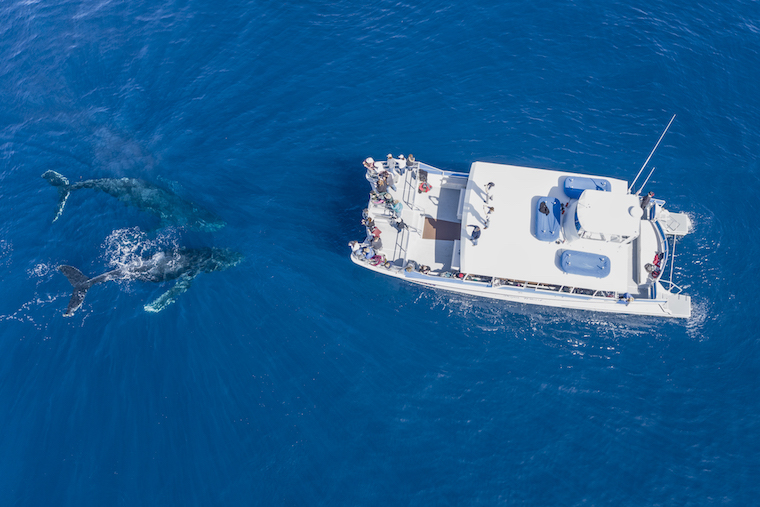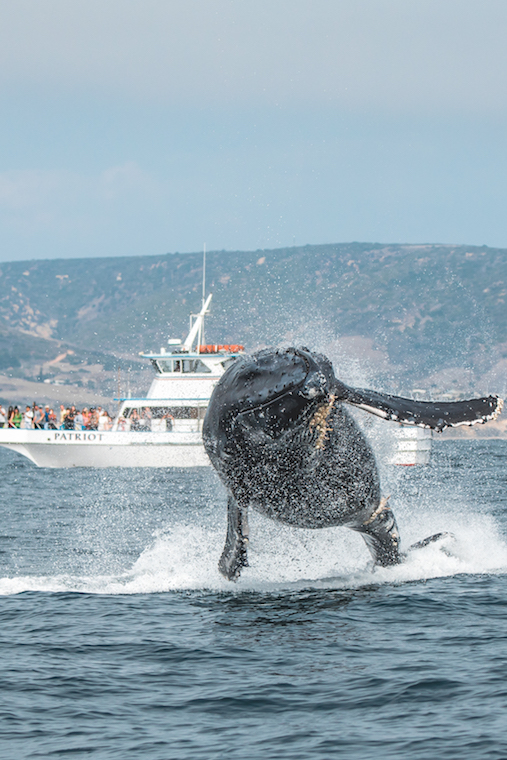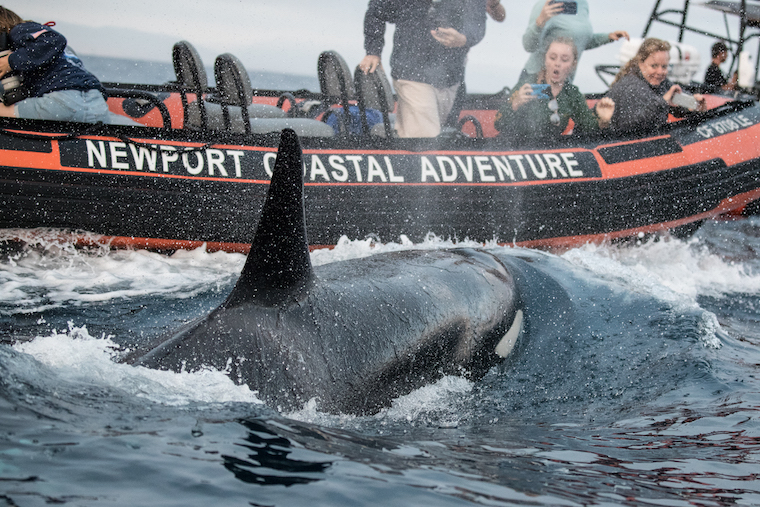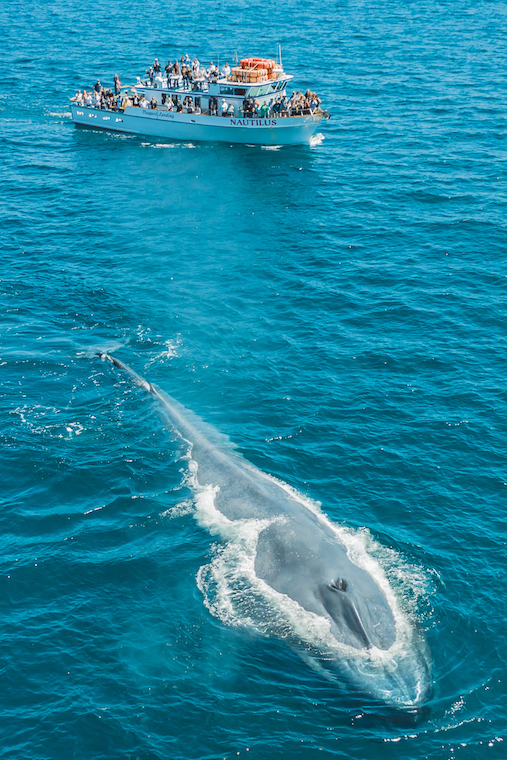
Catch a glimpse of some of the ocean’s largest mammals while aboard local vessels.
By Ashley Ryan
As the glittering waters along the Laguna Beach coastline are marine protected areas, it’s no surprise that various species of whales move in to make this part of the ocean their highway, dinner table and playground.
But, due to the protection afforded to local tides and their underwater ecosystems, hopping aboard a boat to embark on a whale watching tour is simply out of the question here in town. Luckily, neighboring cities like Newport Beach and Dana Point offer trips of their own, venturing through our waters in search of these incredible creatures. And with special precautions in place due to COVID-19, this pandemic-friendly activity is one the whole family can safely enjoy together.
“I’ve had many encounters with passengers on board that had never seen a whale before, and most that have no background knowledge at all before stepping onto our vessels,” says Jessica Roame, education programs manager at Newport Landing Whale Watching. “And we are so fortunate to get the time on board with so many people each day to educate, engage and excite people about whales.”
These educational outings combine the thrill of learning something new with the anticipation that comes from tracking and observing these impressive mammals in their natural habitats. “We hope … [our guests] go away from each experience with a better appreciation for these animals [and] the ocean,” Roame adds.

Types of Travelers
Orange County is a hotbed for exhilarating whale watching experiences, with as many as five species making appearances each and every year. Two types of baleen whales that are visible year-round are minke and fin whales. The former, which only reach about 35 feet in length, are the smallest baleen whales in North America, dining on plankton, schooling fish and sometimes crustaceans. In contrast, fin whales are among the biggest species, second only to the largest animal to ever live: the blue whale.
Blue whales also frequent local waters, with thousands venturing through the area from late spring through summer or early fall. Coming north from Central America in search of krill—their main food source—blue whales in the Northern Hemisphere typically reach upward of 70 or 80 feet.
“Large baleen whales have a big, puffy spout, which is their breath that we look for out on the open ocean,” Roame notes. “… [With] blue whales, that shoots up into the sky [about] 30 feet.”
Moving into fall, humpback whales start to make more and more appearances as they head down south to their breeding grounds in Mexico and Central America for the winter. These playful creatures are some of the most fascinating to watch, with acrobatics that often include breaching (jumping out of the water), tail lobbing (slapping their tail against the water’s surface) and more.
According to Roame, they also are one of the most boat-friendly species. “Humpback whales are extremely social animals and will sometimes be seen together with other humpbacks … in the area, all feeding together,” she says. “The underside of their flukes, or tail fins, are unique to each individual—like a fingerprint—so you can actually tell the whales apart. And, day after day, you start to get to know the whales as you watch them with guests. It’s so much fun to see whales that you’ve encountered before show up again.”
Another common sighting, especially in the wintertime, is the California gray whale. Covered in colorful barnacles on a slate gray background, with a heart-shaped spout, these baleens are easy to recognize. Also heading south toward Mexico, these whales have the longest migration of any animal on the planet as they come from the Arctic Circle. “Gray whales are coastal navigators, as we see them a mile offshore here in Dana Point,” says Donna Kalez, co-president of Dana Wharf Sportfishing & Whale Watching, noting that the combination of shallow waters, underwater canyons and a nearby continental shelf make Southern California a wonderful highway for migrating whales. More rare sightings include orcas and sperm whales.
According to Roame, almost all large whales are listed as endangered, largely due to the whaling industry that was prominent in oceans around the world until the 1980s. “Now, whales face threats like ocean pollution, climate change and overfishing,” she explains, adding that she hopes guests of Newport Landing Whale Watching will go out and do the work necessary to keep the world’s oceans healthy.

Touring the Tides
Setting out on the open water with views of the California coastline is always a thrill, but keeping your eyes peeled for signs of movement in the waves below adds an extra special element. While whales are always the main attractions, guests may also spot common, bottlenose or Pacific white-sided dolphins as well as sea lions, sunfish, sharks, turtles, pelicans and other sea birds.
With multiple two-hour trips leaving the harbor every day, Dana Wharf Sportfishing & Whale Watching will ensure a good time is had by all. “Dana Point Harbor is small and has no large buildings, large ships or oil rigs that distort the whale watching views. It’s like a small slice of Hawaiian life here in Southern California,” Kalez says.
“Every trip is a new experience,” she adds, noting that the best time to go out is in the morning when the water is calm. “… Whale watching is year-round, and marine mammal sightings are guaranteed—meaning that if you do not see a whale or a dolphin, we’ll give you a voucher for a free trip.”
The company, which began in the 1970s, offers three different vessels for exploration: Dana Pride, the largest boat; Lot’ A Fun, a state-of-the-art catamaran with 360-degree views; and Ocean Adventures, which has a raised platform for better viewing. “We have onboard naturalists who are there to engage passengers and answer all questions in depth as it relates to what we are seeing,” Kalez says.
Another option is to head north of Laguna to Newport Beach, where the Newport Landing Whale Watching team offers daily, two-and-a-half-hour tours. “When we encounter whales, we take you to them at a safe distance for viewing—all while being narrated by our captains and onboard naturalists,” she explains. There are six boats in the fleet, most of which have both upper and lower viewing decks, a seated galley and a snack bar complete with themed cocktails. The company has been offering tours in the area for more than 20 years, and features a list of recent wildlife sightings on its website.
“There are few places in the world where you can hop aboard a boat and see wild whales and dolphins in their natural habitat year-round,” Roame says, adding that free trip vouchers are given to passengers if no whales or dolphins are sighted during a boat ride. “The whales and dolphins are not on a schedule out in the open ocean, so each time we head out … is special and unique.”

Pandemic Precautions
While there’s no doubt that the COVID-19 pandemic has touched nearly every part of our daily lives, whale watching continues to be a wonderful way to enjoy fresh air, sightseeing and animal encounters while social distancing.
“We are also taking extra safety precautions for COVID-19, limiting the capacity on board all of our whale watching vessels to be bet ween 50 to 60% of their normal capacity to allow for better social distancing,” Roame says of Newport Landing’s efforts. “We’re keeping the boat clean—sanitizing in between and during whale watching trips—and we are requiring all passengers and crew to wear face masks during the whale watching cruises.”
In addition, the company is offering a discount to encourage guests to climb aboard. Use the code “Dolphin55” at checkout for 55% off your tickets.
Dana Wharf is taking similar precautions, limiting the number of guests while requiring face masks and social distancing on each cruise. Hand sanitizer is available for guests to use on the boats while the loading areas at the dock have been labeled to encourage groups to stay 6 feet apart. Passenger flow on the vessels is also guided.
“Adventuring outdoors with family is always a great activity, but luckily, during the pandemic, we have continued to be a good choice … [because our weather] allows us to be outdoors with fresh air on the water,” Kalez says.
Those that are unsure about mingling with others can take advantage of the company’s private whale watching tours, which are designed for families that want to keep within their own social circle.
No matter how you take to the water, exploring the marine life that lives just below the waves is an unbeatable experience that will have you coming back season after season, year after year.




